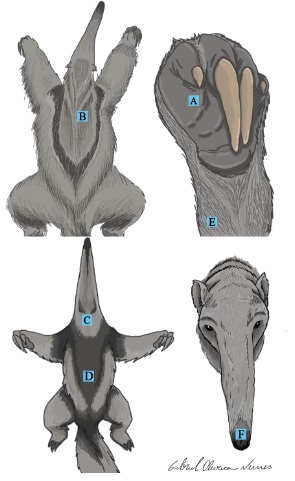Aspects of skin morphology and morphometry of the giant anteater (Myrmecophaga tridactyla, LINNAEUS, 1758)
DOI:
https://doi.org/10.21708/avb.2023.17.1.11123Abstract
The aim of the present study is to describe the skin morphology and morphometry of the giant anteater (M. tridactyla), based on comparative analysis applied to skin segments from central metacarpal torus (palmar pad), dorsal thorax, ventral cervical, ventral abdomen, medial carpal and nasal regions. In order to do so, eight adult specimens of M. tridactyla were used for macroscopic studies and four for microscopic assessments. Microscopy was used to assess fur general features that were macroscopically assessed through visual analysis. Fragments (2.0cm²) were collected from the selected regions for microscopic studies. Samples were fixed on McDowell solution, processed through routine histology techniques and subjected to semi-serial cuts (5 μm). The cuts were stained in HE, Alcian blue and periodic acid Schiff. General morphology of different skin layers was described, as well as their architecture and composition; mesoscopy of the epidermis, dermis and stratum corneum was also carried out. There was difference in skin morphometry between males and females, and between different skin regions in the same animal, based on the statistical evaluation of the recorded values. All epidermis layers were assessed for the selected regions. Dermis encompassed surface and deep layers; it presented sweat and sebaceous glands, as well as hair follicles. Findings also allowed reporting that epidermis components are easily identified given its thickness, and the large amount of sweat glands in it – it contrasts its physiological features.
Downloads

Downloads
Pubblicato
Fascicolo
Sezione
Licenza
Copyright (c) 2023 Acta Veterinaria Brasilica

TQuesto lavoro è fornito con la licenza Creative Commons Attribuzione 4.0 Internazionale.
Autores que publicam na Acta Veterinaria Brasilica concordam com os seguintes termos: a) Autores mantém os direitos autorais e concedem à revista o direito de primeira publicação, com o trabalho simultaneamente licenciado sob a Licença Creative Commons Attribution que permite o compartilhamento do trabalho com reconhecimento da autoria e publicação inicial nesta revista. b) Autores têm autorização para assumir contratos adicionais separadamente, para distribuição não-exclusiva da versão do trabalho publicada nesta revista (ex.: publicar em repositório institucional ou como capítulo de livro), com reconhecimento de autoria e publicação inicial nesta revista. c) Autores têm permissão e são estimulados a publicar e distribuir seu trabalho online (ex.: em repositórios institucionais ou na sua página pessoal) a qualquer ponto antes ou durante o processo editorial, já que isso pode gerar alterações produtivas, bem como aumentar o impacto e a citação do trabalho publicado (Veja O Efeito do Acesso Livre).


 Esta obra está licenciada com uma Licença
Esta obra está licenciada com uma Licença 